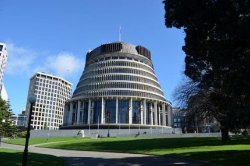Gordon Campbell on royalty and its tourism spin-offs
Gordon Campbell on royalty and its tourism spin-offs
by Gordon Campbell
Ultimately the Queen’s longevity has been one of her most significant accomplishments. A transition to Prince Charles while the monarchy was in the pits of public esteem in the mid to late 1990s would have been disastrous for the Royal Firm. Far more congenial representatives have now emerged. Predictably, the visit of the current royal couple has raised (a) the perennial debate about republicanism and (b) some desperate speculation about what political benefits accrue in election year to politicians from their photo oppportunities with the Duke and Duchess of Cambridge.
Yesterday however, Prime Minister John Key launched his post-Cabinet press conference with yet another dimension of the royal visit by giving an enthusiastic run-down of its alleged tourism benefits to New Zealand. According to Key, the itinerary chosen for the Duke and Duchess of Cambridge had been consciously structured to “showcase” this country as a holiday destination, and that “as Minister of Tourism” he welcomed the royal couple’s presence, citing the value of having 120 members of the travelling media contingent sending images of New Zealand back to an international audience.
So, as well as cementing the constitutional bonds between this country and the British throne, the royal couple have also apparently been props in a tourism campaign for this country - akin to the hobbits and locations from Lord of the Rings, or the America’s Cup campaign. True, it may seem a little undignified for the heir to the throne to be shuttled around the country to scenic locations where the welcoming crowds do their bit as well, by functioning as royalty-friendly backdrops likely to induce British tourists, in particular, to favourably revise their travel plans. (Those visitor numbers from Britain have been down a bit since the Global Financial Crisis hit.)
Dignified or not, any tourism-enhancing role that the Duke and Duchess have been performing on our behalf should be seen as merely the road show version of what the monarchy does back at home. By some 2010 estimates, the monarchy generates about 500 million pounds annually in tourism dollars for the British economy, mainly via visits to palaces and other locations associated with royalty and its pageants. In these and other respects, the monarchy arguably pays its way.
After all, in 2010 figures cited by the Daily Telegraph, the monarchy is on a retainer of 7.9 million pounds annually from the British taxpayer. This so-called “Civil List” payment to the Queen has been frozen for over 20 years, since being set by John Major in 1990. In recent years, the monarchy’s immediate operating expenses have run at a loss. In 2011, the budgeted costs for the Queen’s role as Monarch were reduced from 15.1 million pounds in 2010 to 14.9 million pounds for the following year. (Reportedly, the £7 million gap between this spending and the Civil List payment was met out of Civil List savings made in preceding years).
At a wider level, the annual report for the wider Sovereign Grant made to the British monarch shows that this figure stood at £31 million for 2012-13, £36.1 million for 2013-14 and £37.9 million for 2014-15. The amount of the Sovereign Grant is set at 15% of the income account net surplus of the Crown Estate for the financial year, two years beforedhand. The royal budget operates under a sinking lid mechanism to prevent the amount of the Sovereign Grant increasing beyond what is necessary, if there happens to be significant growth in the revenues from the Crown Estate.
Ah, the Crown Estate. As the Telegraph also helpfully explained, the Civil List/Sovereign Grant system dates from 1760, when George III surrendered the income from the Crown Estate to the government in exchange for the monarchy getting a fixed annual payment from the Treasury:
The taxpayer gained an exceptional bargain from that arrangement: last year, total government spending on all functions of the monarchy amounted to £7.9 million from the Civil List, £22.6 million in grants-in-aid for communications, travel and property from the Department for Culture, Media and Sport, and £4.6 million from other departments. That total of £35.1 million is dwarfed by the £226.5 million profit passed to the Treasury by the Crown Estate.
And that’s before, as mentioned, you get into the hundreds of millions of dollars that the royal pantomine racks up among foreign and local tourists. (Patriotically, the Telegraph does not mention the vast holdings of the Duchy of Cornwall, and the opportunity cost of them being controlled by the Prince of Wales and his minions.) As for any benefits to New Zealand of being a supporting act and offshore location for this ancient institution....by and large, we have been getting the coverage that Key was seeking, from the Shotover jet trip to the Duchess’ wearing of London based, New Zealand designer Emilia Wickstead - who, Telegraph readers were breathlessly advised, has also kitted out Samantha Cameron. Predictably the NZ Herald editorialised that the visit has “revitalised” the monarchy, while the Republicanism movement released a poll showing support/opposition to the monarchy being evenly divided, overall, but among those aged 18-30, two thirds would prefer a New Zealander as head of state. Plainly though, this show still has legs.
Maori Party, Bring A
Plate
One institution having branding problems
right now is the Maori Party. Its role as a champion of the
underprivileged took something of a hit yesterday with
revelations by Maori Television’s Native Affairs
programme that it had organised a fund-raising dinner with
the Prime Minister as the top attraction - whereby those who
fronted up with $5,000 would get guaranteed face time with
John Key at some point in the evening. For a politcial party
that has been bleeding support because of its role in
propping up National in government, this maybe wasn’t the
most desirable look - even if an ‘ends justify means/take
the money and run’ approach has been the Maori Party’s
modus operandi for quite some time now.
At the same time, the Mana Party was also hard at work been positioning itself closer to affluence and influence, in its ongoing negotiations with the Internet Party. It remains to be seen whether Labour or Mana.Com will be more adept at using social media and other forms of outreach to the young, disaffected voters that both claim to be targeting. An interesting guesstimate by Rob Salmond at the Polity site claims that even if this union comes about and ultimately produces three Mana.Com MPs in September, the net gain to the centre-left would be one MP. Talking of pageantry, the picture used by the NZ Herald of Hone Harawira (annual salary: circa $162,000) hitch-hiking home was also pretty timely. However accidentally, it gave a useful lesson to the Maori Party in the imagery required for budding champions of the dispossessed.
ENDS


 Binoy Kampmark: The Australian Defence Formula, Spend! Spend! Spend!
Binoy Kampmark: The Australian Defence Formula, Spend! Spend! Spend! Ian Powell: New Hospital Building Trumps ‘Yes Minister’ Hospital Without Patients
Ian Powell: New Hospital Building Trumps ‘Yes Minister’ Hospital Without Patients Mike Treen: Prices Are Still Rising - It's A Cost Of Living Crisis
Mike Treen: Prices Are Still Rising - It's A Cost Of Living Crisis Gordon Campbell: On When Racism Comes Disguised As Anti-racism
Gordon Campbell: On When Racism Comes Disguised As Anti-racism Peter Dunne: Newshub And TVNZ Tip Of Media Iceberg
Peter Dunne: Newshub And TVNZ Tip Of Media Iceberg Harry Finch: Austerity – For And Against
Harry Finch: Austerity – For And Against